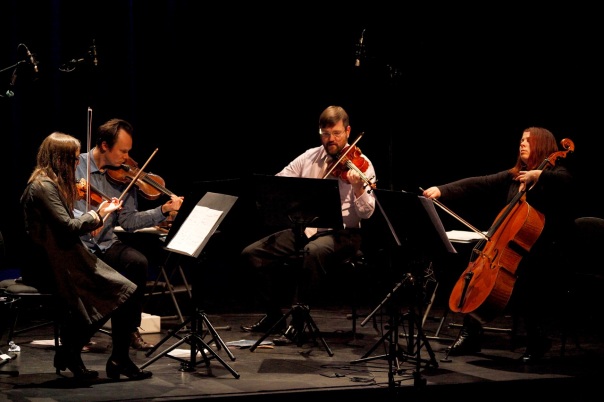
Review by Matthew Lorenzon
Each year BIFEM reserves box-office takings to commission new works for the following year. By commissioning works from Australian and international composers, BIFEM has become a globally recognised hub for new music. This year’s closing concert foregrounded BIFEM’s culture-building mission by juxtaposing world premieres from the emerging Australian composers Caterina Turnbull and Samuel Smith with Australian premieres by Clara Iannotta and Anahita Abbasi. The Argonaut String Quartet handled the challenges thrown at them with apparent ease, whether Turnbull and Smith’s palettes of extended string techniques or Iannotta and Abbasi’s blocks of styrofoam, aluminium foil, and desk bells.
Last year Turnbull participated in the Monash University Composers’ Workshop at BIFEM. Her string quartet attracted the attention of the festival organisers and ultimately a commission from Julian Burnside, QC. Burnside’s support gave Turnbull the opportunity to return to her short piece, extending and refining it into a series of tableaux of delicately layered instrumental effects. In Eminulos (a latin adjective describing a slight projection), masses of bird-like chirps, imitative call and response, booming down bows, tremolos, harmonics, and whispering circular bowing tumble into one another like folded geological layers. Turnbull’s heterophonic effects seem to augment the string quartet into a string orchestra.
Those familiar with Smith’s music will recognise his dynamic musical gestures in Dead Oceans, one of this year’s BIFEM Box Office Commissions. Throughout the work’s 18 minutes these gestures are built into breathtakingly dense and fluid textures. Growling notes evaporate into indeterminately high harmonics; glissandi careen around the instruments, turning corners with screeches of gritty bow pressure. From masses of mercurial lines emerge staggered legato bowing from Elizabeth Welsh and Erkki Veltheim’s violins. These rafts of timbral respite drift atop Graeme Jennings and Judith Hamann’s busy viola and cello parts like flotsam bobbing on the ocean. The work’s general movement from dissonance to consonance lends a sense of nostalgia or repose to the second half. The bobbing legato tones sound like parts of buildings floating on the ocean after being swept out to sea by a storm. The work’s environmental program is suggested by its subtext, “I’ve been out in front of a dozen dead oceans” from Bob Dylan’s “A Hard Rain’s a-Gonna Fall”. But Smith insists, like Dylan, that it is just that, a subtext.
Clara Iannotta’s A Failed Entertainment was similarly not inspired by the dark comedy of David Foster Wallace’s Infinite Jest, for which “A Failed Entertainment” was the working title. A Failed Entertainment is the beginning of the composer’s process of exploring longer and more complex forms, which Wallace achieved with extended, digressionary footnotes. A Failed Entertainment is a similarly masterful combination of finessed writing and awkward interruptions, including “footnotes” played by stamping on desk bells.
Abbasi’s Distorted Attitudes IV – Facile Synthesis shines a spotlight on the timbral possibilities of the cello, which the rest of the quartet frames and accompanies while drawing nearer to its timbre. In the beginning, Hamann ceremonially strums the prepared cello with wide movements of her arm, the aluminium foil between the strings emitting a deep and resonant buzz like the chains on the back of a Persian daf drum. Hamann’s uneven, declamatory rhythms break the tension of the other instruments’ groaning and creaking overbowed strings. Sometimes the cello moves closer to the sound of the other instruments, as when Hamann flicks the edge of the cello with the hair of the bow (a swashbuckling move as effective to see as to hear). Meanwhile, the other instruments emit gentle “puffs” by bowing the sides of their instruments. At other times the other instruments move closer to the cello’s sound, as when the viola’s strings are prepared with blu-tac to change their pitch and timbre. The piece is just one of a series of “Distorted Attitudes” exploring distorted social perspectives and social attitudes towards distortion. I hope we have the chance to hear the rest of them live.
At the end of the day, who doesn’t love a string quartet? It’s an approachable genre that can gently prise open even the most unadventurous ears. The Argonaut String Quartet’s deft execution of microtones, extended techniques, and instrument preparations provides Australian composers and listeners with an invaluable musical resource. With the Argonaut String Quartet, everybody can rest assured that bespoke pitch systems will be accurately reproduced, while non-traditional performance techniques will be treated with the utmost musical sensitivity.
Dead Oceans
Argonaut String Quartet
Capital Theatre
The Bendigo International Festival of Exploratory Music
3 September 2017
Caterina Turnbull, Eminulos; Samuel Smith, Dead Oceans; Anahita Abbasi, Distorted Attitudes IV – Facile Synthesis; Clara Iannotta, A Failed Entertainment
